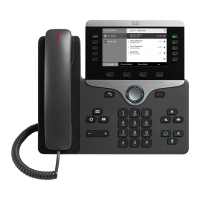Table 16: Overview of Security Features
DescriptionFeature
Signed binary files (with the extension .sbn) prevent tampering with the firmware image
before the image is loaded on a phone.
Tampering with the image causes a phone to fail the authentication process and reject the
new image.
Image authentication
Encrypted binary files (with the extension .sebn) prevent tampering with the firmware image
before the image is loaded on a phone.
Tampering with the image causes a phone to fail the authentication process and reject the
new image.
Image encryption
Each Cisco IP Phone requires a unique certificate for device authentication. Phones include
a manufacturing installed certificate (MIC), but for additional security, you can specify
certificate installation in Cisco Unified Communications Manager Administration using the
Certificate Authority Proxy Function (CAPF). Alternatively, you can install a Locally
Significant Certificate (LSC) from the Security Configuration menu on the phone.
Customer site certificate installation
Occurs between the Cisco Unified Communications Manager server and the phone when
each entity accepts the certificate of the other entity. Determines whether a secure connection
between the phone and a Cisco Unified Communications Manager should occur; and, if
necessary, creates a secure signaling path between the entities by using TLS protocol. Cisco
Unified Communications Manager does not register phones unless it can authenticate them.
Device authentication
Validates digitally signed files that the phone downloads. The phone validates the signature
to make sure that file tampering did not occur after file creation. Files that fail authentication
are not written to Flash memory on the phone. The phone rejects such files without further
processing.
File authentication
Encryption prevents sensitive information from being revealed while the file is in transit to
the phone. In addition, the phone validates the signature to make sure that file tampering did
not occur after file creation. Files that fail authentication are not written to Flash memory
on the phone. The phone rejects such files without further processing.
File encryption
Uses the TLS protocol to validate that no tampering to signaling packets has occurred during
transmission.
Signaling authentication
Each Cisco IP Phone contains a unique manufacturing installed certificate (MIC), which is
used for device authentication. The MIC provides permanent unique proof of identity for
the phone and allows Cisco Unified Communications Manager to authenticate the phone.
Manufacturing installed certificate
Uses SRTP to ensure that media streams between supported devices prove secure and that
only the intended device receives and reads the data. Includes creating a media master key
pair for the devices, delivering the keys to the devices, and securing the delivery of the keys
while the keys are in transport.
Media encryption
Cisco IP Phone 8800 Series Administration Guide for Cisco Unified Communications Manager
85
Supported Security Features

